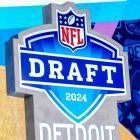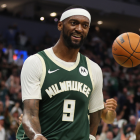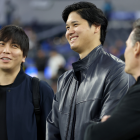There are a lot of top offensive line options available in the 2019 Draft, so if you're an NFL team looking for a quality tackle or interior offensive line prospect, you're in luck. There are favorable NFL comparisons for many of the top prospects both inside and outside.
Draftees don't intend to guarantee a prospect will have the exact same career as his professional counterpart, and that's important to remember. In this series, I'll go through the top prospects at every position and give NFL comparisons -- some current players, some former. These comparisons are not based on size. They're almost solely stylistic.
Previous installments: Quarterbacks, Running Backs, Wide Receivers
(Prospects are listed in the order they appear in my draft rankings.)
As for the actual draft, you'll be able to stream our live coverage right here on CBS Sports HQ (or download the CBS Sports app for free on any mobile or connected TV device) breaking down all the picks and everything you need to know during draft weekend.
Offensive Tackle
Jonah Williams, Alabama
NFL comparison: David Bakhtiari
Bakhtiari has become the NFL's best pass-blocking left tackle, and he's reliable in the run game despite not having desired measurables or athleticism. Williams is the same type of unique prospect. Smaller and not supremely athletic relative to others at the position, he's exquisite with technique and boasts highlight-reel nastiness in the run game. In all, Williams taps into every bit of his talent with ultra-efficient movements both with his footwork and hands. I do remember Bakhtiari repeatedly stymieing inside moves, and that's the one area that -- on rare occasions -- gave Williams problems in 2018.
Dalton Risner, Kansas State
NFL comparison: Bryan Bulaga
Risner provides more positional versatility than Bulaga and is a little more twitched up as an athlete. Both were dominant pass and run blockers in college who occasionally had problems anchoring against speed-to-power rushers. Then again, Risner didn't really have problems dealing with Montez Sweat early in the season, and we now know how ridiculous of a specimen he is. With a few more pounds and some time in an NFL strength and conditioning program, Risner can be a complete right tackle. At this point, like Bulaga, he's quick enough in his kick slide to deal with speed, fires his hands at the correct time, can recover, and is a bully in the run game.
Jawaan Taylor, Florida
NFL comparison: Trent Williams
Williams was picked in the first round of the 2010 draft after a dazzling career at Oklahoma in which he showcased franchise tackle power in the run game and ideal fundamentals with his hands and feet to be an above-average pass protector. Since then, he's become one of the most well-rounded tackles in football. Taylor is a wide, heavy-handed blocker who will drive opponents into the ground in the run game and uses his smooth athleticism to deal with speed rushers. Power rushers don't give him issues. Like Williams was, Taylor can be tested by quick, low-to-the-ground defenders because he's not an elite athlete, but don't mistake Taylor for a plodding tackle prospect.
Andre Dillard, Washington State
NFL comparison: Terron Armstead
Armstead is more explosive of an athlete than Dillard, which gives context for how gifted the Saints left tackle is, because Dillard was the clearly the most athletic tackle at the combine. However, their styles are very comparable. Armstead wins with sheer quickness to the pass-rushing apex -- where edge rushers either turn the corner or are pushed off it. He's also fantastic with his punch timing and accuracy as a pass blocker. So is Dillard. He fires back into his kick slide and is tremendous with his hands. Because Dillard and Armstead are so fast, they rarely look uncomfortable as pass blockers and get the extra split second needed to sink their hips and anchor if they see a bull rush coming. When Armstead entered the league out of Arkansas Pine-Bluff, he was behind as a run blocker. The same goes for Dillard, who simply didn't get the normal amount of run-game reps in Washington State's Air Raid system.
Yodny Cajuste, West Virginia
NFL comparison: Taylor Lewan
Cajuste is a long, powerful left tackle prospect who wins with good enough functional athleticism but mostly the ability to dominate with strength at the point of attack. He shows refinement with a nice repertoire of his own counter moves. Cajuste looks to knock down opponents' hands as they get into his chest. Much of the same was said about Lewan as he entered the NFL out of Michigan. But also like Lewan, the speed in Cajuste's kick slide can be pushed to the limit by fast edge rushers.
Kaleb McGary, Washington
NFL comparison: Cam Robinson
Robinson was one of the most roller coaster evaluations I've ever done for an offensive tackle. On one series, he'd look like the No. 1 overall pick in the draft. The next possession he'd look like an undrafted free agent with a severe lack of balance in pass protection or accuracy at the second level. That essentially describes McGary, a large, long, highly athletic tackle with a major boom or bust game.
Chuma Edoga, USC
NFL comparison: Laremy Tunsil
Tunsil was more of a finished product in 2016 than Edoga is now as a draft prospect. They're similar players though. Bessed with "gliding" movements on the field, Edoga held down the right side of USC's line awesomely despite being under 6-foot-4. He has long arms and uses his physical superiority to his advantage in space in the run game and can handle any type of rusher on the outside in pass protection. Tunsil's bounced around on the Dolphins' line, and there's a thought Edoga could add 10-15 pounds and flourish as an athletic guard.
Derwin Gray, Maryland
NFL comparison: Donovan Smith
Somewhat sluggish in his movements but just athletic enough to get the job done as a pass protector. That describes Smith and Gray. Like Smith, Gray's girth and length really help to mask athletic deficiencies. Better on pass plays than paving lanes for the run, Gray has a chance to land in the middle of the draft and start at left tackle early in his career.
Interior Offensive Line
Terronne Prescod, OG, NC State
NFL comparison: Brandon Brooks
Probably my biggest #DraftCrush that goes against the consensus -- Prescod wasn't invited to the combine -- the NC State star is a massive human at around 6-5 and 330-ish pounds. Despite those measurements, Prescod was asked to get lateral in the Wolfpack's zone-blocking scheme, and in doing so he was a pleasant surprise. In pass protection, Prescod can be beaten by super-quick penetrators. The same was true for Brooks when he came into the league. However, like Brooks, Prescod is a wall in pass protection, even if it doesn't always look textbook. Bull rushes don't faze him, and while he may be a tick slow reacting to twists, he's aware of them, and if he gets his hands on those twisting defensive linemen, it's over. In a power scheme, or even if loses some weight, Prescod can be an awesome value selection in the draft.
Cody Ford, OG, Oklahoma
NFL comparison: Kelechi Osemele
During his pre-draft process, some saw Osemele as a tackle. Some saw him as a guard. He played on the edge at Iowa State and began his career with the Ravens at that position. An injury during the playoffs precipitated a move to guard, and the rest is history. Osemele's explosiveness and mean streak combination allowed him to become the best young guard in football. Ford is a similar tweener, with feet capable enough for him to stay on the outside if need be. I think his best position is guard because of his athleticism and strength blend.
Chris Lindstrom, OG, Boston College
NFL comparison: Joel Bitonio
Lindstrom is a guard with tackle feet. I've written that often about the Boston College star because that's the first thing I think about when evaluating him. The move to guard in his senior season worked wonders for his draft stock, and he crushed the combine workouts. Like Bitonio -- who played tackle at Nevada -- Lindstrom is equally as impactful in the pass game as he is road-grading for the run.
Elgton Jenkins, C, Mississippi State
NFL comparison: Travis Frederick
Today, we think of Frederick as probably the most nimble yet powerful center in football. His combine workout didn't indicate he'd flourish thanks to athletic traits, but he was also a people mover at Wisconsin and routinely halted bull rushes with strong legs and an awesome back bend. Jenkins tested better than Frederick yet doesn't look as mobile on the field. Weird how that works sometimes. However, like Frederick, Jenkins is a monster in the run game and yawns at bull rush attempts. He has a massive 83-inch wingspan too. Jenkins is comparable to Frederick because he's as NFL-ready as they come at the center position.
Garrett Bradbury, C, NC State
NFL comparison: Jason Kelce
Get Bradbury in an NFL strength and conditioning program for a year or two and a zone-blocking scheme ... and watch him flourish. He has the loosest hips and quickest feet I've ever scouted at the center spot. He's just a little top heavy right now and doesn't have the strength or weight to anchor. Like Kelce, Bradbury is ultra-aware of stunts and has the elite lateral mobility to pick up multiple assignments on a given play. He's tremendous in space on sweeps and screens too.
Lamont Gaillard, C, Georgia
NFL comparison: Rodney Hudson
Hudson was an ox in the run game at Florida State and that strength and good athleticism allowed him to punish defensive tackles while staying in front them in pass protection. That's exactly what you'll get with Gaillard. Hudson was knocked for his lack of size, and that was probably the main reason he fell to the second round of the 2011 draft. Gaillard has excellent film -- especially in the run game -- and surprised many by measuring in with 33 1/2-inch arms at the combine. He also was just under 6-3.
Beau Benzschawel, OG, Wisconsin
NFL comparison: Rob Havenstein
Havenstein is a tackle and Benzschawel is a guard, but they're similarly sized and nearly identical games. Benzschawel creates impressive push in the run game and flashes a quality anchor. He gets into trouble when needing to shift laterally. That's the one area that hurt Havenstein while at Wisconsin too.
Erik McCoy, C, Texas A&M
NFL comparison: Mike Pouncey
McCoy is a plus-athlete for the center position and never stops battling. He's a low center of gravity type yet can be hurt by powerful bull rushers, which is something that gave Pouncey problems at Florida. McCoy is pretty consistent with his balance but will get caught bending at the waist on occasion.





















